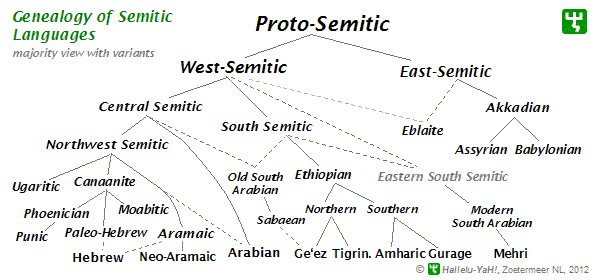Some of you might think that reading Akkadian texts written in cuneiform involves some kind of magic, but I must say that it is actually a very logically built language, which can quite easily be learnt. The hardest part of it is that we have Akkadian sources for almost 2 millennia, and if you consider that English was not even a language two millennia ago, then you can understand that Akkadian changed a lot in the course of that time. Furthermore, the script has some advantages and some disadvantages. Biggest disadvantage: cuneiform is hard; even the most famous Assyriologists can probably not read every text on sight, and untrained Assyriologists cannot even read the simplest of texts from the tablet. Biggest advantage: cuneiform is (partly) syllabic, which means that we have vowels (yay!).
A Semitic language
Why Akkadian might seem difficult at first sight, is because it does not belong to the same linguistic family as English, Dutch, or French. It is a Semitic language – whereas the others mentioned are Indo-European. There is no consensus about the detailed reconstruction of the Semitic language family, but it includes Hebrew, Arabic, Aramaic and many other languages. Akkadian seems to have formed a separate eastern branch (based on both its geographical location and linguistic characteristics).

Akkadian itself can be subdivided into Assyrian (northern Mesopotamia) and Babylonian (southern Mesopotamia), which then again can be split up chronologically, as you can see in the following table. Standard Babylonian was a register of the language used for literature, from ca. 1000 BC onwards.
|
Old-Akkadian ca. 2500-1950 BC |
|
| Old-Babylonian ca. 1950-1550 BC | Old-Assyrian ca. 1950-1750 BC |
| Middle-Babylonian ca. 1530-1000 BC | Middle-Assyrian ca. 1500-1000 BC |
| Neo- and Late Babylonian ca. 1000 BC – 75 AD | Neo-Assyrian ca. 1000-600 BC |
|
Standard Babylonian |
|
How does it work?
Akkadian words are built with a meaning-bearing root generally consisting of three consonants, which is poured into a pattern to create both verbs and/or nouns. For example: the root prs bears a meaning of “cutting” or “dividing”. If it is poured into the pattern which forms the verb in the infinitive, it becomes parāsum, “to divide”. If one wants to create a noun, it can for example be pārisum, “the one who divides”. There are exceptions of roots with two or four consonants, and sometimes one of the consonants can be “weak”, which means that they are half-consonant, half-vowel (y = i; w = u).
| form | pattern | root | word |
| infinitive | C1-a-C2-ā-C3-um | C1 = p, C2 = r, C3 = s | parāsum |
| active participle | C1-ā-C2-i-C3-um | C1 = p, C2 = r, C3 = s | pārisum |
Nouns can be either feminine or masculine, and are singular, dual or plural. There is also noun-declination, which means that the noun gets a case-ending indicating nominative (subject), accusative (direct object) or genitive (possession, indirect object). I illustrate here with the word šarrum [sharrum] “king”.
| masculine | nominative | accusative | genitive |
| singular | šarrum | šarram | šarrim |
| dual | šarrān |
šarrīn |
|
| plural | šarrū |
šarrī |
|
| feminine | nominative | accusative | genitive |
| singular | šarratum | šarratam | šarratim |
| dual | šarratān |
šarratīn |
|
| plural | šarrātum |
šarrātim |
|
There is no article in Akkadian! They rarely differentiate between “a” and “the”.
Finite verbs are constructed with pre- and suffixes indicating the number and person. We can distinguish between preterite (past tense), praesens (present/imperfect tense), and perfect (perfect tense). For the 3rd person singular, the prefix is i– and there is no suffix:
| preterite |
praesens | perfect |
| iprus “he divided” | iparras “he divides” |
iptaras “he has divided” |
Now you can read a basic Akkadian sentence! For example:
- šarrum iparras “the king divides”
- šarratum šarrī iprus “the queen divided kings”
From cuneiform to translation
When I read a cuneiform text, I will first make a transliteration, which means that I put the cuneiform script into Latin script. Akkadian is generally typed in cursive in modern studies.

šar-ru-um i-pa-ar-ra-as
Then I normalize the text: I connect the different syllables to create existing words.
šarrum iparras
Now, I can easily translate the sentence!
“the king divides”
From here it gets a bit more complicated, but I hope you enjoyed your lesson of Akkadian 101!
I studied Latin. Professor G. Semerano studied Akkadian. Latin was created by Akkadian patricians who created Rome. In other words Semitic created German, Sanskrit, Latin, Greek and so on. Latin words like mare, oppidum, Caesar, manu etc. were simply Akkadian words. Etruscans were Semitic too. I am Semitic too. Up truth, down untruth.
LikeLike